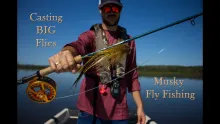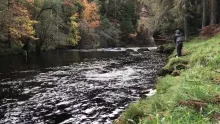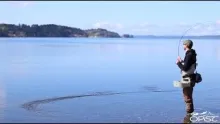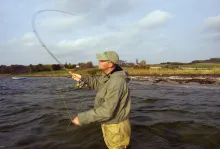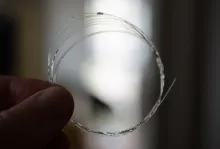What is the proper leader length for given conditions and circumstances?
Discussion of Proper Leader Length
Clearly, one of the looming debates that has never been solved through the ages is "What is the proper leader length for a given circumstance". I can give you the answer right now: It's the leader length that you will use and have confidence to catch fish. So, what I am saying is, after you have assessed the circumstances surrounding catching your quarry, you'll tie on the leader you know you can cast and present the fly in the best possible manner. Let's explore a few opinions from masters of the art.
George Harvey, Gary Borger, Ray Bergman and others have become advocates of longer leader lengths, especially for dry-fly fishing. The belief is the longer leaders will deliver the fly and allow it to drift as though it weren't attached to anything. Others believe longer leaders extend the distance from the fly line to the fly making the connection less obvious. However, longer leaders require longer casts to be effective. Enter William C. Black.
William C. Black, however, subscribes to the theory that leader length is mis-interpreted, mis-used and over-hyped. In his book, "The Art of Flyfishing Smaller Streams", Black writes "Theoretically, the longer and thinner the leader, the better the camouflage. Among flyfishing intelligentsia there is a tendency to regard the length of an angler's leader as commensurate with his degree of skill and sophistication." Black further reduces his concept to casting requirements.
Using long leaders for short casts of, say, less than 25 feet, is futile. "Whipping near pure monofilament about (referring to long leaders and only a few feet of flyline) is very much like whistling in the breeze. Thus, the length of your leader has increasing impact on tackle performance as casts grow shorter." Reducing Black's opinions then, tells us to be smart about using long leaders. If you have short casts, where there will be very little flyline to load the rod, there will be very little energy to turn over a long leader. Shorter casts require shorter leaders, longer casts can activate longer leaders. Incidentally, Black typically uses leaders from 4 to 9 feet and may use longer slack-line leaders for bigger water where a drag-free float is required.
Symptoms of Poor Leader Design
- Leader doesn't turn over at all & lands in a curled-up pile? = Leader butt too light. Not stiff enough, or middle taper too stiff or thick.
- Leader slaps the fly on the water = slow your cast down or use a more supple leader formula.
- Leader 'hinges' - doesn't turn over well? = Several items to check: fly too heavy?, casting too slowly? Leader sections more than 60% difference in diameter size? Using soft leader material for butt section?
- Leader turns over OK except for the tippet section? = Tippet is too supple or light for the fly selection.
- Leader breaks at a knot? = check your knot tying skills!
- Do fish come to your fly and turn away at the last second? = Your tippet is causing too much micro-drag. Lengthen the tippet segment to allow for a small S-curve or go to a smaller diameter tippet.
- Log in to post comments

